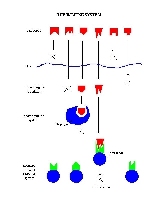| Introduction |
| Recognition of the Immune System |
| Generating Receptor Diversity |
| Affinity Maturation |
| Organizing Principles |
| Possible Architectures |
| Artificial Immune System |
| Summary | Exam. question |
Introduction |
Immune system
It is a unique and fascinating computational system that has evolved to solve a unique problem. We hope that a study of the immune system can suggest new solutions to computer science problems (such as computer security), or at least give us new ways of looking at these problems. Some of the properties of the immune system that might be of interest to a computer scientist are:
These properties result in a system that is scalable, resilient to subversion, robust, very flexible, and that degrades gracefully.
Problem solved by the immune system
The immune system uses distributed detection to solve the problem of distinguishing between self and nonself, which are elements of the body, and foreign elements respectively (actually, the success of the immune system is more dependent on its ability to distinguish between harmful nonself, and everything else).
This a hard problem
Over view of immune system
 Figure . Immune System defenses are multi-layered.
Figure . Immune System defenses are multi-layered.
The immune system has a multi-layered architecture, with defenses on many levels (see figure ). Most elementary is the skin, which is the first barrier to infection. Another barrier is physiological, where conditions such as pH and temperature provide inappropriate living conditions for foreign organisms. Once pathogens have entered the body, they are dealt with by the innate immune system and by the acquired immune response system. The innate immune system primarily consists of the endocytic and phagocytic systems, which involve roaming scavenger cells, such as phagocytes, that ingest extracellular molecules and materials, clearing the system of both debris and pathogens. The acquired immune response is the most sophisticated and involves a host of cells, chemicals and molecules. It is called acquired because it is responsible for the immunity that is adaptively acquired during the lifetime of the organism.
This overview will focus on the acquired immune system because it is the most complex, and has potentially the most interesting solutions to offer computer science. It has to be the most complex, because any pathogens that manage to evade the previous layers in the body's defenses will be much harder to detect and eliminate, i.e. they will be much better adapted to evading the body's defenses.
The acquired immune system consists of certain types of white blood cells,
called lymphocytes, that cooperate to detect pathogens and assist in
the destruction of those pathogens. These lymphocytes can be thought
of as detectors which are tiny compared to the body. There are
millions of lymphocytes, so what we have is a system of highly
distributed detection, where there is no centralised control, and
little, if any, heirarchical control. Detection and elimination of
pathogens is a consequence of millions of small cells - detectors -
interacting through simple, very localised rules, to give rise to a
truly efficient distributed system.
NEXT: Recognition